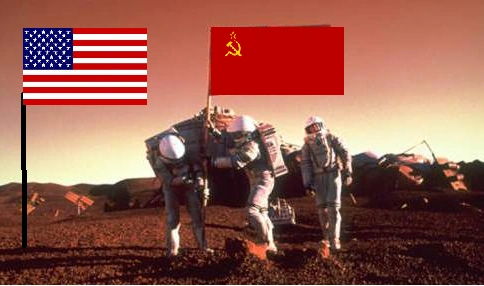
The Joint TMK/Apollo Mars mission of 1979
In 1963 President Kennedy stood before the United States and announced an offer for a joint, US/Soviet Moon mission. According to Sergei Khrushchev his father (then Leader of the Soviet Union) had second thoughts about turning the offer down. What if he had accepted? What if the two great Superpowers, joined together and combined their technology, scientific energies and most of all funds to explore the Cosmos together. This is a different Space Race.
TMK/Apollo Mars[]
The next phase of exploration, building on the success of the Lunar landings was a Mars mission. The US decided to allow Soviet cosmonauts to be part of the crew as a show of co-operation during the dente period. Launched in 1979 the Spacecraft based on the space stations built by the US and USSR provided living space for up to four people. Nuclear Thermal Rocket upper stage doubled the amount of payload while using less fuel. The Ship with mass of 150 tonnes (fully fueled) took seven months of transit before aerobraking in Mars orbit. Alexi Leonov and Buzz Aldrin would also enter the history books after setting foot on the Martian surface. The ice discovered on the first month of exploration was latter found to contain Mircrobial life. The crew would spend 1 year on the surface before leaving for the 7 month trip back to earth finally splashing down in 1982. The same technology would later be used to conduct Venus flyby and orbital missions.
Spacebases[]
With semi permanent landing missions to all the easy to get to inner planets NASA and the newly created civilian agency SSA turned their sights to longer more permanent infrastructure. One of these projects was an Orbital base. So in 1980 the fully reusable Space Shuttle (utilizing a flyback booster) began transporting crew and cargo up to the new Space Base 1. With a maximum capacity of 50-100 people the station housed international astronauts from all over the world (Brazil, Canada, Britain, East/West Germany, Vietnam, etc). With lower launch costs space research and later manufacturing became practical. By 1999 even some airlines began transporting passengers into space. Similar modules to those used on Spacebase1 were used to construct a 12 person base on the moon in 1981. By 1999 the on space population grew to 400, the Lunar population to 100 and the Mars population to 50.
